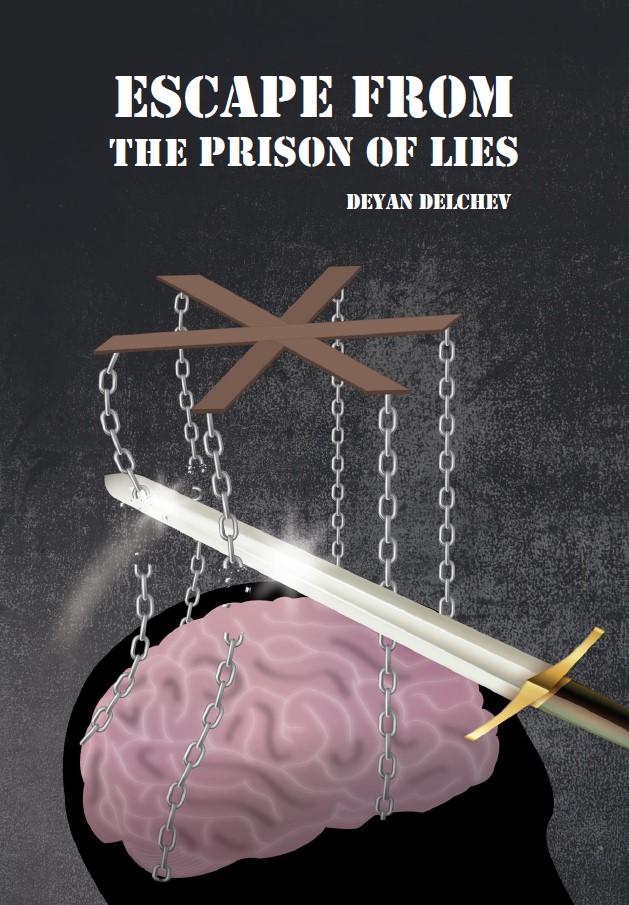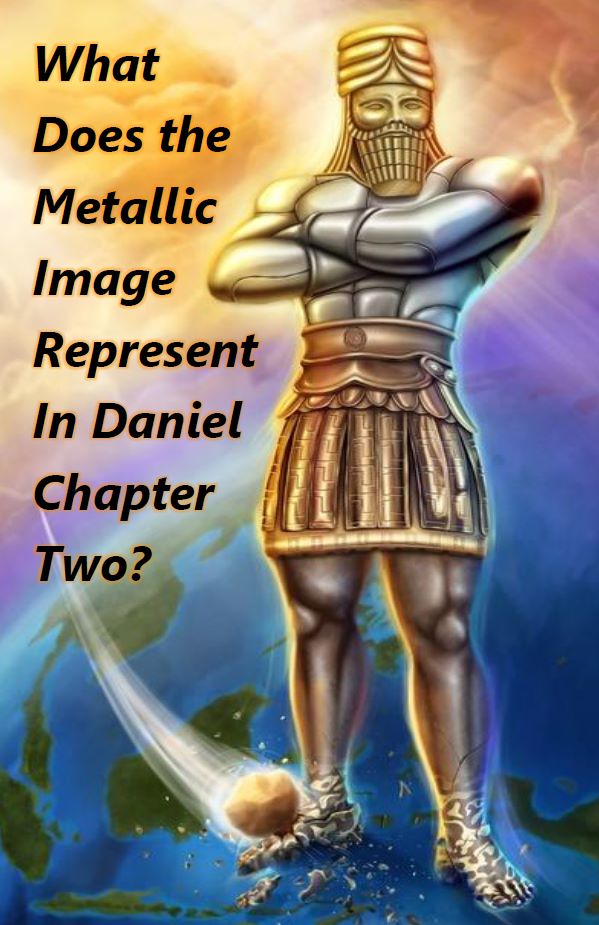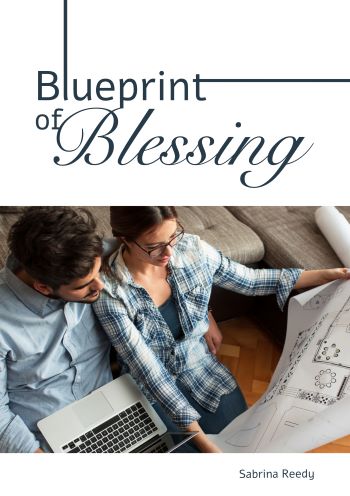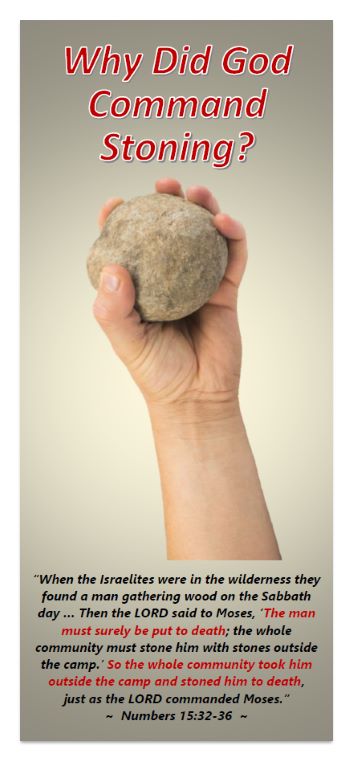(Daniel 8:14-27) Why Does the Sanctuary Need to be Cleansed?
“Let them make Me a sanctuary, that I may dwell among them.” (Exodus 25:8)
We begin our study of the sanctuary after Moses and the Israelites escaped from Egyptian bondage and are wondering through the wilderness. God had great plans for His chosen people and by having them erect a sanctuary in His name it would be a place where He could dwell among them. God told Moses, "Let them make Me a sanctuary, that I may dwell among them." (Exodus 25:8).
God wanted this sanctuary to be made according to a certain criteria. God told Moses that the sanctuary should be built “according to all that I show you, that is, the pattern of the tabernacle of all its furnishings, just so you shall make it.” (Exodus 25:9). While God was talking with Moses, He showed him a pattern, or a blueprint if you will, of how the sanctuary should be built.
An Overview of the Sanctuary
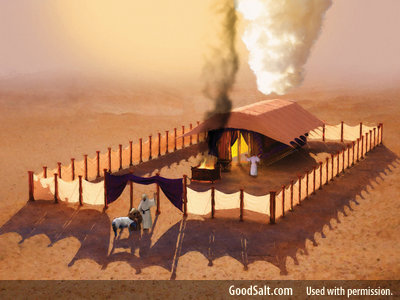 The area surrounding the sanctuary was called “the court.” It was fenced in by a hanging made of fine woven linen. All the pillars and sockets which held the curtains were made of bronze while the hooks and pillars were made of silver. The door or gate of the court was a screen made from fine woven linen of blue, purple and scarlet colors. The court was 150 feet long, 75 feet wide, and 7 1/2 feet tall. (You can read more about the court in Exodus 25:9-19; Exodus 38:9-20).
The area surrounding the sanctuary was called “the court.” It was fenced in by a hanging made of fine woven linen. All the pillars and sockets which held the curtains were made of bronze while the hooks and pillars were made of silver. The door or gate of the court was a screen made from fine woven linen of blue, purple and scarlet colors. The court was 150 feet long, 75 feet wide, and 7 1/2 feet tall. (You can read more about the court in Exodus 25:9-19; Exodus 38:9-20).
The first thing you would see as you entered the courtyard was the “altar of burnt offerings.” This altar was made from acacia wood and was 3 feet high and 7 1/2 feet wide and long. There were four horns that were attached to the four corners of the altar and the entire altar was overlaid with bronze. All the other utensils of pans for the ashes, shovels, basins, firepans, and forks were all made of bronze. There were four bronze rings attached to the four corners of the altar where they would slide in two poles, one on each side, in order to carry it.
It was upon this altar where they would offer their burnt offerings. Every morning and evening “a lamb without blemish” was burnt on the altar on behalf of the entire nation of Israel (Exodus 12:5). This was known as the “daily ministration.” However, when an individual had sinned he/she would bring “a lamb without blemish” to the courtyard as a “sin offering” on behalf of that individual only. At the entrance of the court a priest would greet the person and lead him/her into the courtyard. There the person would confess his/her sins by holding their hand upon the lamb’s head while the priest tied the lamb to a stake in the ground. The sinner would then proceed to slit the lamb’s throat and carry it over and burn it upon the altar of burnt offerings. (You can read more about the altar of burnt offerings in Exodus 27:1-8; Exodus 38:1-7; Leviticus 1).
The next piece of furniture in the courtyard was a bronze laver that was placed between the altar of burnt offerings and the sanctuary. The laver was filled with water for the priests to wash their hands and feet. (You can read more about the bronze laver in Exodus 30:17-21).
The sanctuary itself was made from acacia wood and covered with curtains made of fine woven linen with blue, purple, and scarlet thread. Upon the curtain was the artistic design of angelic beings. The sanctuary tent was about 45 feet long and 15 feet wide. (You can read more about the sanctuary tent in Exodus chapter 26).
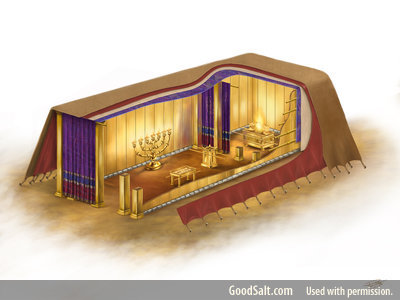 Inside the sanctuary were two rooms divided by a veil. The first room was called the Holy Place. Unlike the furniture overlaid with bronze in the outer court the furniture inside the sanctuary was overlaid with pure gold. There were three pieces of furniture inside the Holy Place. On the left (southside) was a golden menorah (lampstand) consisting of six branches (for a total of seven lamps). This menorah was to remain lit continuously. Everyday the priest would trim its wicks and make sure it contained plenty of oil. (You can read more about this menorah in Exodus 25:31-40).
Inside the sanctuary were two rooms divided by a veil. The first room was called the Holy Place. Unlike the furniture overlaid with bronze in the outer court the furniture inside the sanctuary was overlaid with pure gold. There were three pieces of furniture inside the Holy Place. On the left (southside) was a golden menorah (lampstand) consisting of six branches (for a total of seven lamps). This menorah was to remain lit continuously. Everyday the priest would trim its wicks and make sure it contained plenty of oil. (You can read more about this menorah in Exodus 25:31-40).
On the right (northside) was a golden table called the Table of Showbread. Upon the table was placed twelve cakes of bread divided into two piles of six. This bread was also called “the bread of the presence” because it was to remain in the presence of God always. Every Sabbath the bread was to be eaten only by the priests and replaced with new loaves. The table for the Showbread was about 3 feet long, 18 inches wide, and 2 feet 3 inches tall. (You can read more about this table and the Showbread in Exodus 25:23-30; Leviticus 24:5-17).
Straight ahead in the Holy Place was the golden Altar of Incense. This altar was placed just before the veil which separates the two apartments of the sanctuary. The priest would burn incense upon this altar at the time he tended to the menorah. The morning and evening services were commenced with the burning of the incense. God spoke up against the use of burning “strange incense on it, or a burnt offering, or a grain offering; nor shall you pour a drink offering on it.” (Exodus 30:9). The altar was about 18 inches long, 18 inches wide, and about 16 inches high. (You can read more about the altar of incense in Exodus 30:1-10).
Beyond the inner veil which divided the sanctuary tent was a room called the Holy of Holies (or, Most Holy Place). The Holy of Holies was about 15 feet cubed. The Ark of the Covenant was placed inside this room. The ark was overlaid with gold and was about 27 inches high, 27 inches wide, and about 36 inches long. Inside the ark was placed the two stone tablets engraved with the “Ten Words” (commonly known as the 10 Commandments) which were written with God’s own finger. Also, inside the ark was placed a golden pot of manna (Exodus 16) and Aaron’s rod that budded (Numbers 17:1-11; Hebrews 9:3,4).
On top of the ark was placed a lid called the Mercy Seat. Upon this Mercy Seat was placed two angelic statues, one on each end, facing each other and looking down at the Mercy Seat while their wings stretched out above them covering the Mercy Seat. God would come down and dwell upon the Mercy Seat between the two angels in the form of a cloud-like object called the Shekinah (or, Shechinah) which means “resting place” or “visible presence of God.” Thus God, in the form of a cloud, came down and dwelt among His people upon the mercy Seat in the Holy of Holies of the sanctuary (see, 1 Kings 8:10-13), revealing His resting place and foundation of His justice is mercy:
“Justice and judgment are the habitation of thy throne: mercy and truth shall go before thy face.” (Psalm 89:14)
Sin, however, has caused us to misrepresent God in our minds. It has clouded His everlasting love and mercy.
“But your iniquities have separated between you and your God, and your sins have hid (clouded) His face from you, that He will not hear.” (Isaiah 59:2)
Isaiah is not saying that God is so disgusted with us that He turns away and plugs His ears. No, it is sin that is causing us to perceive God is rejecting us. The whole sanctuary service is a picture lesson revealing how WE perceive God and how He longs to cleanse us from our faulty thinking.
Because of His love for us, God desires to make an atonement (re-establish oneness) with His creation. Not that His mind changes or is reconciled towards us, but that we are changed and reconciled to Him as we finally see His everlasting character of love. God desires to once again dwell in you. By giving the sanctuary and its services God was revealing “the way” He would bring about this atonement (oneness) with His people. What is “the way”?
“Thy Way, O God, Is In the Sanctuary”
“Thy way, O God, is in the sanctuary: who is so great a God as our God?” (Psalm 77:13)
“The way” - the path of salvation - is found in the sanctuary. When Jesus was on the earth He said, “I am THE WAY, the truth, and the life. No one comes to the Father except through Me.” (John 14:6). Every inch of the sanctuary was teaching mankind how God and His Son would deal with the disease of sin. They must do something in order to release us from the curse of doubting God’s loving character. Sin has deceived us into believing God does not freely forgive.
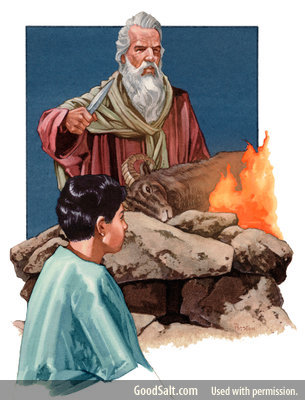 Scripture teaches that “without the shedding of blood there is no remission.” (Hebrews 9:22). This is a fact, however, whose thinking is this? God’s or man’s? Is God so angry at us that He must see blood in order to forgive us? Or is man so depressed in his guilt that he believes God desires and requires death to atone for sin like all the other pagan deities?
Scripture teaches that “without the shedding of blood there is no remission.” (Hebrews 9:22). This is a fact, however, whose thinking is this? God’s or man’s? Is God so angry at us that He must see blood in order to forgive us? Or is man so depressed in his guilt that he believes God desires and requires death to atone for sin like all the other pagan deities?
“Sacrifice and offering Thou (God) didst not desire; mine ears hast Thou opened: burnt offering and sin offering hast Thou not required.” (Psalm 40:6)
God has never desired nor required the killing of anything or anyone in order to forgive us. This is a man-made idea caused by sin hiding (clouding) God’s merciful face. We read something very interesting in the book of Jermiah:
“For I (God) did not speak to your fathers, or command them in the day that I brought them out of the land of Egypt, concerning burnt offerings or sacrifices. But this is what I commanded them, saying, Obey My voice, and I will be your God, and you shall be My people. And walk in all the ways that I have commanded you, that it may be well with you.” (Jeremiah 7:22–23)
After reading these passages one must ask, “Why then did God institute the sacrificial system?” The point to make clear here is that God has never required a sacrifice, but man, in our faulty thinking, does. God instituted the animal offerings to accommodate OUR thinking. God gave His Son over to OUR faulty justice system. This was the only way we would believe in His forgiveness.
After our first human parents (Adam and Eve) sinned, the human race was changed. Our thinking towards God changed. They remembered God’s words saying, “Of every tree of the garden thou mayest freely eat: But of the tree of the knowledge of good and evil, thou shalt not eat of it: for in the day that thou eatest thereof thou shalt surely die.” (Genesis 2:16, 17). The serpent, however, told them “Ye shall not surely die” (Genesis 3:4). When they did not die right away they began to believe the serpent’s suggestions that they are immortal beings, not dependent upon God for life. Thus the warning that they would surely die became to them as a threat from God. Satan, “that old serpent … which deceiveth the whole world” (Revelation 12:9), had deceived them into believing that death is not the natural result of sin (Romans 6:23, James 1:14, 15) therefore, death must come from an outside force. He led them to believe God’s justice demands the death of a sinner and He would soon be coming to execute this judgment upon them.
“And they heard the voice of the LORD God walking in the garden in the cool of the day: and Adam and his wife hid themselves from the presence of the LORD God amongst the trees of the garden. And the LORD God called unto Adam, and said unto him, Where art thou? And he said, I heard Thy voice in the garden, and I was afraid, because I was naked; and I hid myself.” (Genesis 3:8-10)
Adam and Eve believed God was coming to judge, condemn, and execute a death penalty against them. In other words, they thought God was coming to kill them. It was Adam who first cast judgment onto God by projecting his own faulty sense of justice upon Him.
“And He (God) said, Who told thee that thou wast naked? Hast thou eaten of the tree, whereof I commanded thee that thou shouldest not eat? And the man said, The woman whom Thou gavest to be with me, she gave me of the tree, and I did eat.” (Genesis 3:11-12)
First off we read the words, “Who told thee that thou wast naked?” It wasn’t God who condemned Adam, therefore, it wasn’t God whom Adam should be afraid of. Next we read Adam’s response, “The woman whom Thou gavest to be with me, she gave me of the tree, and I did eat.” Here Adam is reflecting his guilt onto God, the One who created the woman who had given him the fruit. Condemnation did not originate with God towards Adam, but with Adam towards God! As a result, we are now all born with the inherited mindset bent toward condemning others, thus attempting to put the blame on others, making them our scapegoat.
“Therefore as by the offence of one (Adam) judgment came upon all men to condemnation; even so by the righteousness of one (Jesus) the free gift came upon all men unto justification of life.” (Romans 5:18)
Most read this verse and conclude that because Adam sinned, God condemned the whole human race. As a result, God would have killed us all in vengeful wrath if it were not for Jesus permitting God to kill Him instead. However, a careful reading of Romans 5:18 suggests Paul is saying that the judgmental and condemning mindset was from Adam unto all men. It is not meant to be understood as God condemning the world. This doctrine of Jesus receiving God's condemning justice in our place in order to appease His wrath against us is commonly called penal substitution.
“The penal substitution theory teaches that Jesus suffered the penalty for mankind's sins. Penal substitution derives from the idea that divine forgiveness must satisfy divine justice, that is, that God is not willing or able to simply forgive sin without first requiring a satisfaction for it.” (Wikipedia)
Penal substitution is also taught by the way some teachers use the word propitiation:
“Herein is love, not that we loved God, but that He loved us, and sent His Son to be the propitiation for our sins.” (1 John 4:10)
Many read this verse and believe God is the One who needed to be propitiated. This is made clearer by reading this verse in the Amplified Bible. Take note that the words in brackets are straight from the Amplified Bible and reflect the translators’ interpretation of the text:
“In this is love, not that we loved God, but that He loved us and sent His Son to be the propitiation [that is, the atoning sacrifice, and the satisfying offering] for our sins [fulfilling God’s requirement for justice against sin and placating His wrath].”
Notice how it is believed that Christ dying as a propitiation is satisfying God’s justice and placating His wrath. To “placate” someone means “you stop them from being angry by giving them something or doing something that pleases them” (vocabulary.com).
This kind of doctrine sounds more like a domestic violence situation than it does the everlasting gospel (Good News). Is this really what we are to proclaim? “Good news! God killed His Son instead of us!” Just listen to how Charles Spurgeon (1834-1892), in his sermon Particular Redemption, describes his understanding of the atonement:
“There was never an ill word spoken, not an ill thought conceived, not an evil deed done, for which God will not have punishment from some one or another. He will either have satisfaction from you, or else from Christ. If you have no atonement to bring through Christ, you must for ever lie paying the debt which you never can pay, in eternal misery; for as surely as God is God, He will sooner lose His Godhead than suffer on sin to go unpunished, or one particle of rebellion unrevenged. You may say that this character of God is cold, and stern, and severe. I cannot help what you say of it; it is nevertheless true. Such is the God of the Bible.”
So, according to this doctrine, we are apparently supposed to believe God was up in heaven saying, “I don’t care who I kill (My Son or mankind), I just want to kill somebody, and then My justice will be satisfied!” However, sin is not punished by God arbitrarily inflicting punishment for it. No, the punishment for sin is God permitting the inherent consequence of our own destructive choice.
“He that shall find Me, shall find life, and shall have salvation from the Lord: But he that shall sin against Me, shall hurt his own soul. All that hate Me love death.” (Proverbs 8:35, 36)
This is speaking of natural consequences. The natural consequence of being in union with Christ is life; for He is “the way, the truth, and the life” (John 14:6). The natural consequence of sin is to hurt yourself which naturally leads to death. God’s design for life is revealed in His Law: “I command thee this day to love the LORD thy God, to walk in His ways, and to keep His commandments and His statutes and His judgments, that thou mayest live and multiply” (Deuteronomy 30:16), and John says “sin is the transgression of the Law” (1 John 3:4). Therefore, sin is the act of separating yourself from God’s design for life as revealed in His Law. Listen to how Dr. Timothy Jennings accurately describes how God’s Law operates:
“As all Bible students know, Scripture tells us that God is love (1 John 4:8), but what many have not considered is that when God built His universe He built it to operate in harmony with His own nature of love. The construction protocol on which God built His universe is known as God’s law. And this law is the law of love, an expression of His nature and character [Isaiah 51:6, 7; Romans 13:10] ... Functionally, Paul describes this law as ‘love seeks not its own,’ or ‘love is not self-seeking’ (1 Corinthians 13:5). This means that love is selfless rather than selfish. Love is giving rather than taking and life is actually built, by God, to operate on this principle of giving. A simple example of this law in action is respiration. With every breath we breathe we give away carbon dioxide (CO2) to the plants, and the plants give back oxygen to us (the law of respiration). This is God’s design for life, a perpetual circle of free giving. It is an expression of God’s character of love, and life is built to operate on it. If you break this law, this circle of giving, by tying a plastic bag over your head and selfishly hoarding your body’s CO2, you break the design protocol for life, and the result is death. ‘The wages [result] of sin is death’ (Romans 6:23). This circle of giving is the law that God constructed life to operate on … The church, after Christ’s ascension, taught a theology that focused on the principles of love and therefore taught Christ’s mission was to reveal truth (John 14:6), defeat Satan (Hebrews 2:14), destroy death (2 Timothy 1:10), and restore the law of love into humankind (1 John 3:8) … Amazingly, the early church understood that Christ’s mission was to rebuild humanity back into God’s original design. They realized that God’s law of love was the template on which He built His universe and rightly realized that in order to save humankind the law on which life is constructed to operate had to be restored into humanity. Christ’s mission was to restore humankind back into harmony with God! But this truth was lost and another concept of law replaced it: Romanism. Imperial Rome’s concept of government and law infected Christian thought after the emperor Constantine converted. Prior to Constantine’s conversion, Christianity understood God’s law as the law of love. After Constantine’s conversion, the Christian church accepted Rome’s change to God’s Law, and what was that change? That God’s Law is an imposed law with no inherent consequence, thus requiring the lawgiver to police breaches in the law and inflict punishment, rather than the truth that God’s Law is the natural law of love, the design protocol on which God created life to operate … Christians lost sight of God’s law of love and instead
accepted an imposed law system modeled after human governments. After all, if they still believed God’s law was the design law of love, like the law of respiration, then would they ever have thought a church committee could vote to change such a law (something the church did vote in committee to do)? [See the study on Who Is the Little Horn? – Part Two]. But they could only vote to change God’s law after they first accepted the concept that His law is imposed, not natural. This idea of an imposed law altered the view of God held by Christians and changed how Christianity functioned. Thus, Christians went from a body of believers who lived communally, shared their possessions to help each other, and died as martyrs, to an organization of Crusades, Inquisition, burning dissenters at the stake, and active participation in genocide (Nazis in Germany and Christians in Rwanda).” (Dr. Timothy Jennings, The Remedy Bible, Preface)
Scripture tells us that, as soon as sin was conceived, a Mediator stood up: “For there is one God, and one Mediator between God and men, the man Christ Jesus.” (1 Timothy 2:5). Jesus is not our Mediator to change God’s mind towards us, but to change our minds towards God. We are the ones who changed after sin entered, not God.
Since Christ is the Mediator after sin entered, then it was He who was speaking to Adam and Eve in the Garden. And since Adam just proclaimed judgment and condemnation upon Christ, then it was Adam, on behalf of fallen mankind, who condemned Christ to death; for He is “the Lamb slain from the foundation of the world.” (Revelation 13:8).
As a result, we inherited that hatred towards God and His Son; “For the fallen mind is hostile towards God” (Romans 8:7). God proved this true when He sent His Son to live as a man among us, and we cried out, “Away with Him, away with Him, crucify Him!” (John 19:15). We continue to prove this today, because every time we choose to sin we are “crucifying the Son of God all over again and subjecting Him to open shame” (Hebrews 6:6).
In Hosea 6:6 God says, “For I desire mercy, not sacrifice, and the knowledge of God rather than burnt offerings.” Jesus refers to this when He said, “But if you had known what this means, ‘I desire mercy and not sacrifice,’ you would not have condemned the guiltless” (Matthew 12:7). Notice how He connects “sacrifice” with the act of them (us) condemning Him to death. God has always desired for us to simply accept His forgiveness without having to make a sacrifice because He has never condemned us. We on the other hand, desire judgment, condemnation and blood in order to satisfy our faulty justice system.
“To what purpose is the multitude of your sacrifices unto Me? saith the LORD: I am full of the burnt offerings of rams, and the fat of fed beasts; and I delight not in the blood of bullocks, or of lambs, or of he goats. When ye come to appear before Me, who hath required this at your hand, to tread My courts? … And when ye spread forth your hands, I will hide Mine eyes from you: yea, when ye make many prayers, I will not hear: your hands are full of blood. Wash you, make you clean (notice why we need cleansing); put away the evil of your doings from before Mine eyes; cease to do evil.” (Isaiah 1:11, 12, 15, 16)
Some may object here and ask, “But isn’t the sacrificial system part of God’s eternal Law?” Those who believe that animal sacrifices are a part of God’s justice system believe that the only reason we aren’t sacrificing animals today is because there is no temple and no Levitical priests at the present time. They believe that at some point in time Jesus Himself will return and reinstitute the system of animal offerings because it is part of God’s eternal Law. Some even believe animal offerings have been going on from all eternity in heaven (even before sin) because they say it’s part of being Torah (Law) observant. But notice what is written in 1 Samuel:
“Does the LORD take pleasure in burnt offerings and sacrifices? Or does He find pleasure when people obey Him? Certainly, obedience is better than sacrifice, and listening is better than the fat of rams.” (1 Samuel 15:22)
Take careful notice that obedience to God’s Law (Torah) is separate from performing animal offerings. God says He desires obedience (to His Law) rather than burnt offerings, the same way as He said He desires for us to come into “the knowledge of God” rather than for us to partake of “burnt offerings” in Hosea 6:6. The truth is, if we had always obeyed God’s eternal Law, there would have never been any need for God to reveal our faulty thinking through animal offerings.
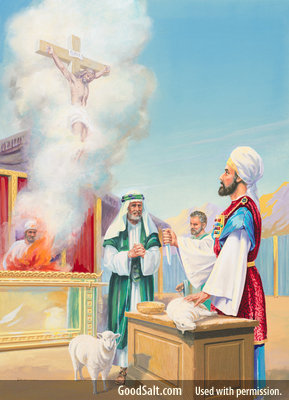 Out of Their everlasting love, God and His Son would thus accommodate our thinking. If it’s blood we want, then it’s blood we shall get. The whole sacrificial system was God’s way of revealing our fallen justice system – a satanic justice system which is inconsistent with mercy. Each animal that was offered pointed forward to Jesus, the true “Lamb of God who takes away the sin of the world” (John 1:29). Just as the lamb was to be “without blemish” (Exodus 12:5; Leviticus 23:12), we are saved by the “precious blood of Christ, as of a lamb without blemish and without spot” (1 Peter 1:19). Saved from what? From God’s anger and wrath toward us? No, saved from our own self-guilt, self-condemnation and from doubting God’s forgiveness. Because of God’s great love for us, He had to give His Son over to our faulty thinking, paying us the ransom price that we demanded, thus setting us free from the law of sin and death. The sacrifice of Christ was not to appease God, but to appease us! Think about that. The literal definition of the word forgiveness is “to release a debt.” If God had set the ransom price of death and needed to punish Jesus in order to forgive us and appease His wrath, He would have gotten paid and didn’t really forgive anything. But the truth is, the cross doesn’t achieve God’s forgiveness, it displays His everlasting forgiveness. In other words, God did not forgive us because Jesus died on the cross, the Messiah died on the cross in order for us to believe He has forgiven us:
Out of Their everlasting love, God and His Son would thus accommodate our thinking. If it’s blood we want, then it’s blood we shall get. The whole sacrificial system was God’s way of revealing our fallen justice system – a satanic justice system which is inconsistent with mercy. Each animal that was offered pointed forward to Jesus, the true “Lamb of God who takes away the sin of the world” (John 1:29). Just as the lamb was to be “without blemish” (Exodus 12:5; Leviticus 23:12), we are saved by the “precious blood of Christ, as of a lamb without blemish and without spot” (1 Peter 1:19). Saved from what? From God’s anger and wrath toward us? No, saved from our own self-guilt, self-condemnation and from doubting God’s forgiveness. Because of God’s great love for us, He had to give His Son over to our faulty thinking, paying us the ransom price that we demanded, thus setting us free from the law of sin and death. The sacrifice of Christ was not to appease God, but to appease us! Think about that. The literal definition of the word forgiveness is “to release a debt.” If God had set the ransom price of death and needed to punish Jesus in order to forgive us and appease His wrath, He would have gotten paid and didn’t really forgive anything. But the truth is, the cross doesn’t achieve God’s forgiveness, it displays His everlasting forgiveness. In other words, God did not forgive us because Jesus died on the cross, the Messiah died on the cross in order for us to believe He has forgiven us:
“For God so loved the world, that He gave His only begotten Son, that whosoever believeth in Him should not perish, but have everlasting life. For God sent not His Son into the world to condemn the world; but that the world through Him might be saved (from our faulty thinking).” (John 3:16, 17)
I believe E.J. Waggoner (1855-1916) gives us the correct view of why Christ became a “propitiation”:
“A Propitiation. - A propitiation is a sacrifice. The statement then is simply that Christ is set forth to be a sacrifice for the remission of our sins. ‘Once in the end of the world hath he appeared to put away sin by the sacrifice of himself.’ Hebrews 9:26. Of course the idea of a propitiation or sacrifice is that there is wrath to be appeased. But take particular notice that it is we who require the sacrifice, and not God. He provides the sacrifice. The idea that God’s wrath has to be propitiated in order that we may have forgiveness finds no warrant in the Bible. It is the height of absurdity to say that God is so angry with men that he will not forgive them unless something is provided to appease his wrath, and that therefore he himself offers the gift to himself, by which he is appeased … The Christian idea of propitiation is that set forth above. The heathen idea, which is too often held by professed Christians, is that men must provide a sacrifice to appease the wrath of their god. All heathen worship is simply a bribe to their gods to be favorable to them. If they thought that their gods were very angry with them, they would provide a greater sacrifice, and so human sacrifices were offered in extreme cases [Micah 6:6-8]. They thought, as the worshipers of Siva in India do today, that their god was gratified by the sight of blood.” (E.J. Waggoner, The Signs of the Times, Vol. 22, January 23, 1896)
So again, is it true that without the shedding of blood there is no remission? The answer is yes and no.
- No, because all Adam and Eve had to do was believe, accept and receive God’s forgiveness, because God never desired nor required a sacrifice in order for Him to forgive us.
- Yes, because mankind was so deeply rooted in believing the pagan idea that there must be blood in order for God to forgive us, Jesus had to shed His blood and break Satan's "spell" in order for us to believe, accept and receive God’s forgiveness.
In the book of Romans, Paul writes:
“[Christ] whom God hath set forth to be a propitiation through faith in His blood, to declare His righteousness for the remission of sins that are past, through the forbearance of God; To declare, I say, at this time His righteousness: that He might be just, and the justifier of him which believeth in Jesus.” (Rom 3:25-26)
The Greek word used for propitiation here is ἱλαστήριον (hilasterion), which actually means "mercy seat." Yes, it's referring to the lid of the Ark of the Covenant. This word is used only one other time in the Greek New Testament where the writer of Hebrews is discussing the mercy seat lid of the Ark:
“And over it the cherubim of glory shadowing the mercyseat; (hilasterion) of which we cannot now speak particularly” (Hebrews 9:5)
In other words, Paul was saying "Christ is set forth to be a mercy seat." This suggests that hilasterion is a place where mercy is given. Now, hilasterion is a derivitive of the word ἱλάσκομαι (hilaskomai) which means, "be merciful, make reconciliation." The only two verses that use hilaskomai are:
“And the publican, standing afar off, would not lift up so much as his eyes unto heaven, but smote upon his breast, saying, God be merciful (hilaskomai) to me a sinner.” (Luke 18:13)
“Wherefore in all things it behoved Him (Jesus) to be made like unto His brethren, that He might be a merciful and faithful High Priest in things pertaining to God, to make reconciliation (hilaskomai) for the sins of the people.” (Hebrews 2:17)
So, Paul is not trying to tell us that God needed to be appeased, but instead that God presented Jesus as the way and the means of restoration (reconciliation/atonement) through the established evidence of God’s true character revealed in Christ. By Christ revealing God's true character to us, we become reconciled to God through Christ. Not because He appeased God's wrath, but that we now finally believe and trust that "God is love" and that He never condemned us nor needed to be appeased in any way shape or form.
Doesn’t this sound more like Good News than a story about an abusive Father who gets angry and needs to punish, kill, or torture us when we disobey Him? This is why Jesus said, “I am the way, the truth, and the life: no man cometh unto the Father, but by Me” (John 14:6). Jesus, the spotless Lamb, is “the way” to the Father as revealed in the sanctuary service. While on earth as a man, Jesus revealed the true character of the Father:
“If ye had known Me (Jesus), ye should have known My Father also: and from henceforth ye know Him, and have seen Him. Philip saith unto Him, Lord, show us the Father, and it sufficeth us. Jesus saith unto him, Have I been so long time with you, and yet hast thou not known Me, Philip? he that hath seen Me hath seen the Father; and how sayest thou then, Show us the Father? Believest thou not that I am in the Father, and the Father in Me? the words that I speak unto you I speak not of Myself: but the Father that dwelleth in Me, He doeth the works.” (John 14:7-10)
Everything Jesus did on earth was a full manifestation of His Father because it was His Father doing the works in and through Him. Never once did Jesus condemn anyone. Never once did Jesus kill anyone. He only healed and restored all who came to Him. Why? Because He permitted His Father’s Spirit to work in and through Him!
Our Bronze-Thinking Revealed
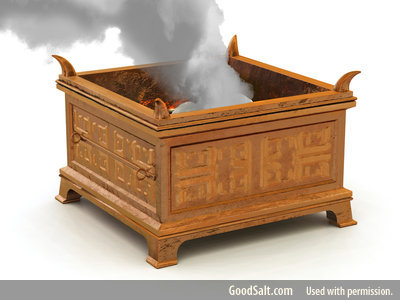 Earlier we learnt that in the courtyard of the sanctuary was an altar of burnt offerings and a laver which were both overlaid with bronze. The King James Version says brass, but bronze is more accurate. It is very significant that these were made of bronze while the objects inside the sanctuary were made of gold. Unlike gold which is a God-created metal, bronze is a man-made alloy of copper and tin created by “Tubal-cain, who made all kinds of bronze and iron tools.” (Genesis 4:22). In Scripture, tin is identified with "dross", or "impurities" which needs to be cleansed:
Earlier we learnt that in the courtyard of the sanctuary was an altar of burnt offerings and a laver which were both overlaid with bronze. The King James Version says brass, but bronze is more accurate. It is very significant that these were made of bronze while the objects inside the sanctuary were made of gold. Unlike gold which is a God-created metal, bronze is a man-made alloy of copper and tin created by “Tubal-cain, who made all kinds of bronze and iron tools.” (Genesis 4:22). In Scripture, tin is identified with "dross", or "impurities" which needs to be cleansed:
“And I will turn My hand upon thee, and purely purge away thy dross (impurities), and take away all thy tin.” (Isaiah 1:25)
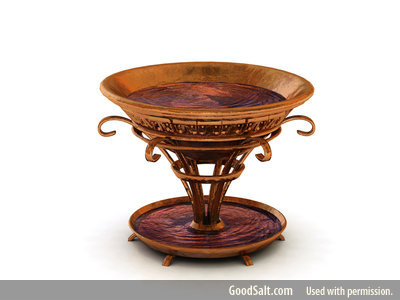 Notice God wants to cleanse us from our tin. Bezalel was in charge of creating the furniture for the sanctuary and “he made the laver of bronze and its base of bronze, from the bronze mirrors of the serving women who assembled at the door of the tabernacle of meeting.” (Exodus 38:8). Why from the bronze mirrors? To reveal that the rituals carried out in the courtyard were a witness against man— a reflection upon our own impure understanding of the atonement— and how God and His Son lovingly gave Themselves over to satisfy that false understanding. Isaiah prophesied that mankind would misunderstand the cross, thinking God was the one who was afflicting His Son as punishment for our sins, but in reality we were to see that it was our sins which killed Jesus, and not our loving Father:
Notice God wants to cleanse us from our tin. Bezalel was in charge of creating the furniture for the sanctuary and “he made the laver of bronze and its base of bronze, from the bronze mirrors of the serving women who assembled at the door of the tabernacle of meeting.” (Exodus 38:8). Why from the bronze mirrors? To reveal that the rituals carried out in the courtyard were a witness against man— a reflection upon our own impure understanding of the atonement— and how God and His Son lovingly gave Themselves over to satisfy that false understanding. Isaiah prophesied that mankind would misunderstand the cross, thinking God was the one who was afflicting His Son as punishment for our sins, but in reality we were to see that it was our sins which killed Jesus, and not our loving Father:
“Surely He (Messiah/Jesus) hath borne our griefs, and carried our sorrows: yet we did esteem (erroneously believed) Him stricken, smitten of God, and afflicted. But He was wounded for (or, by) our transgressions, He was bruised for (or, by) our iniquities: the chastisement of our peace was upon Him; and with His stripes (wounds) we are healed … He was oppressed, and He was afflicted (by us), yet He opened not His mouth: He is brought as a lamb to the slaughter, and as a sheep before her shearers is dumb, so He openeth not His mouth (He uttered no words against us).” (Isaiah 53:4, 5, 7)
The bronze in the courtyard revealed God sending His Son in the form of a man to accommodate our faulty view of what constitutes divine justice. Now that Christ has died mankind can be reconciled unto God, no longer doubting His forgiveness. Looking into the laver we see our own faces, our own faulty characters which caused the death of the Son of God. By washing in the laver we are now ready to begin to understand God’s character more fully as we follow Christ our High Priest through the veil into the sanctuary.
Christ Our High Priest
Paul wrote, “... when He (Jesus) had by Himself purged our sins, sat down on the right hand of the Majesty on high.” (Hebrews 1:3). This tells us that, after Jesus ascended into heaven, He began another stage of the plan of salvation. The ancient sanctuary revealed this when the blood from the lamb was applied, not only upon the four horns of the altar, but also inside the sanctuary tent. The services continued after the lamb was slain and burnt on the altar. This reveals that the plan of salvation goes beyond the cross! Otherwise there would have been no need for a sanctuary. If the plan of salvation was completed at the altar of burnt offerings, what need would there have been for the sanctuary? And if Christ appeased God's wrath and justice against sinners on the cross, as some claim, why then are we still here?
About 30 years after Jesus ascended into heaven Paul wrote, “Being confident of this very thing, that He (God) which hath begun a good work in you will perform (complete) it until the day of Jesus Christ (second coming).” (Philippians 1:6). Clearly we see that God began a work in His people after the cross! This “work” has to do with the application of the blood by our High Priest:
“Now of the things which we have spoken this is the sum: We have such a High Priest, who is set on the right hand of the throne of the Majesty in the heavens; A minister of the sanctuary, and of the true tabernacle, which the Lord pitched, and not man.” (Hebrews 8:1, 2)
After His ascension into heaven, Jesus became our great High Priest of a heavenly sanctuary which is “the true tabernacle, which the Lord pitched, and not man.” This heavenly sanctuary is the “pattern” that God showed to Moses when He told him to build the earthly sanctuary. Paul says that the earthly sanctuary and its services was an “example and shadow of heavenly things, as Moses was admonished of God when he was about to make the tabernacle: For, See, saith He, that thou make all things according to the pattern shown to thee in the mount.” (Hebrews 8:5).
Remember, Jesus as our High Priest is leading us from our own faulty thinking to the way in which God thinks. God has told us:
“For My thoughts are not your thoughts, neither are your ways My ways, saith the LORD. For as the heavens are higher than the earth, so are My ways higher than your ways, and My thoughts than your thoughts.” (Isaiah 55:8, 9)
This is why the ultimate goal of the New Covenant condition is to have God’s Law written in our hearts and minds:
“For this is the covenant that I will make with the house of Israel after those days, saith the Lord; I will put My laws into their mind, and write them in their hearts: and I will be to them a God, and they shall be to Me a people.” (Hebrews 8:10)
But remember, the Law of God is in the Holy of Holies in the Ark of the Covenant. Jesus is leading us there through the Holy Place first. Thus the sanctuary represents Jesus’ work in us, bringing us closer and closer to understanding the Father and His Law more fully. No one comes to the Father except through Him!
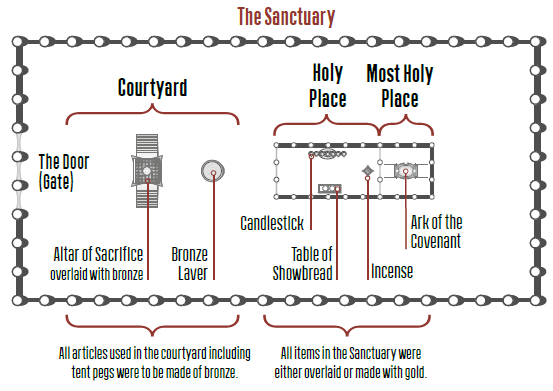
“The one who judges to condemnation and whose offense caused death to reign is Adam. Adam thought that God both condemned him and desired to put him to death. Therefore, these are the two areas of the Sanctuary that must be revealed in men. The Sanctuary is a rectangle that spatially creates two squares. At the centre of the first square is the altar of sacrifice. At the centre of the second square is the ark of the covenant.” (Adrian Ebens, As You Judge, p. 76)
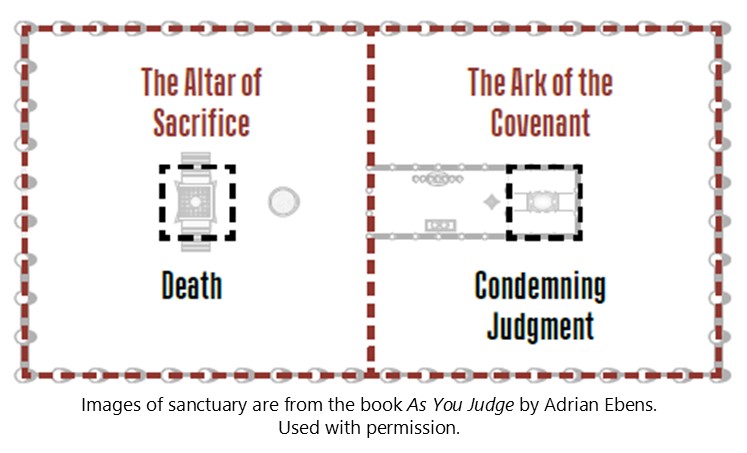
The work God began in man after the cross is correcting our fallen view of the atonement and His Law. Without the correct view of the atonement, we will not have the correct view of how God’s Law operates, and vice versa. However, with a correct view of the atonement, we will have a correct view of how God’s Law operates, and vice versa. Therefore, when both views are corrected, we will have the correct view of our Father’s character!
The Holy Place
The prophet John, while in vision, was instructed to “measure the temple of God, the altar (of incense), and those who worship therein” but was told not to measure the courtyard “for it has been given over to the gentiles.” (Revelation 11:1-2). The “gentiles” here represent all those unbelievers not willing to follow Jesus, our High Priest, into a deeper and purer understanding of the knowledge of God and His ways. They have chosen not to enter into the heavenly temple (sanctuary) by faith and “worship therein.” (Hebrews 8:1-2; 7:22-25). They remain in the courtyard entertaining their bronze (man-made) justice system of penal substitution, thus never fully coming into the knowledge of God’s true character of love represented by the golden furniture.
The Table of Showbread
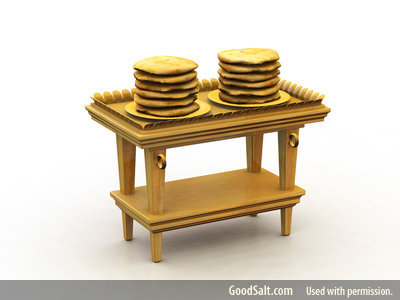 Moving into the first apartment of the sanctuary, to the north we see the table which held the twelve pieces of bread separated into piles of six. This bread was called “Showbread” or “bread of the presence.” Jesus once said “I am the Bread of life” (John 6:48). He also referred to Himself as being the bread (manna) which was given to Moses and the Israelites by saying:
Moving into the first apartment of the sanctuary, to the north we see the table which held the twelve pieces of bread separated into piles of six. This bread was called “Showbread” or “bread of the presence.” Jesus once said “I am the Bread of life” (John 6:48). He also referred to Himself as being the bread (manna) which was given to Moses and the Israelites by saying:
“I am the living Bread which came down from heaven. If anyone eats of this Bread, he will live forever; and the Bread that I shall give is My flesh, which I shall give for the life of the world.” (John 6:51)
In John 1:1 and Revelation 19:13, Jesus is referred to as being the “Word of God.” Since Jesus said, He is the living Bread and “If anyone eats of this Bread, he will live forever”, then we are to continuously eat of “the Word of God” which is “the bread of life.” By doing this we are spiritually eating and digesting Jesus who is the Word and Bread (John 6:55-58). Jeremiah once said, “Thy words were found, and I did eat them; and Thy word was unto me the joy and rejoicing of mine heart” (Jeremiah 15:16).
“The bread upon the table primarily represents Christ as the Word of God to fallen humanity and is provided for the spiritual nourishment of our souls in Christian growth. What physical food is to the body, the word of truth is to man’s spiritual nature. The necessity of consistent and earnest Bible study in the Christian experience cannot be overemphasized. This responsibility is a life-or-death matter for the believer. As a man cannot maintain physical life without partaking of temporal food for the nourishment of his body, neither can he live spiritually without partaking of spiritual food for the nourishment of his soul. As it is written, ‘Man shall not live by bread alone, but by every word that proceedeth out of the mouth of God’ (Matthew 4:4).” (Ty Gibson, The Path of the Just, p. 44)
It is of no coincidence that this table was placed on the north end. The north is where Scripture places God’s throne, of which Satan wants to take control:
“How art thou fallen from heaven, O Lucifer, son of the morning! how art thou cut down to the ground, which didst weaken the nations! For thou hast said in thine heart, I will ascend into heaven, I will exalt my throne above the stars of God: I will sit also upon the mount of the congregation, in the sides of the north: I will ascend above the heights of the clouds; I will be like the most High.” (Isaiah 14:12-14)
In Matthew 19:28 Jesus said:
“… Verily I say unto you, That ye which have followed Me, in the regeneration when the Son of man shall sit in the throne of His glory, ye also shall sit upon twelve thrones, judging the twelve tribes of Israel.”
It is of no coincidence that when Luke quotes Jesus, he adds the word “table”:
“And I appoint unto you a kingdom, as My Father hath appointed unto Me; That ye may eat and drink at My table in My kingdom, and sit on thrones judging the twelve tribes of Israel.” (Luke 22:29, 30)
The table of showbread had two crown moldings (Exodus 25:24, 25). This shows the two crowns who sit at that throne – God, the Most High and His Prince; for it is “the throne of God and of the Lamb (Jesus).” (Revelation 22:3).
In prophetic vision, the prophet John saw Jesus while ministering His way through the heavenly sanctuary. He first saw Jesus in this throne room in Revelation chapters 4 and 5:
“After this I (John) looked, and, behold, a door was opened in heaven: and the first voice which I heard was as it were of a trumpet talking with me; which said, Come up hither, and I will show thee things which must be hereafter. And immediately I was in the spirit: and, behold, a throne was set in heaven, and One sat on the throne … And out of the throne proceeded lightnings and thunderings and voices: and there were seven lamps of fire burning before the throne, which are the seven Spirits of God … And I saw in the right hand of Him that sat on the throne a book written within and on the backside, sealed with seven seals. And I saw a strong angel proclaiming with a loud voice, Who is worthy to open the book, and to loose the seals thereof? And no man in heaven, nor in earth, neither under the earth, was able to open the book, neither to look thereon. And I wept much, because no man was found worthy to open and to read the book, neither to look thereon. And one of the elders saith unto me, Weep not: behold, the Lion of the tribe of Judah, the Root of David (titles of the Messiah), hath prevailed to open the book, and to loose the seven seals thereof. And I beheld, and, lo, in the midst of the throne … stood a Lamb as it had been slain … And He (the Messiah/Jesus) came and took the book out of the right hand of Him (God, the Father) that sat upon the throne.” (Revelation 4:1, 2, 5; 5:1-7)
Clearly John is looking into the first apartment of the heavenly sanctuary, wherein was the golden table of showbread (the throne) and the “seven lamps of fire” (the golden Menorah). We will discuss the meaning of the "seven seals" mentioned above in a future study.
The Golden Menorah
T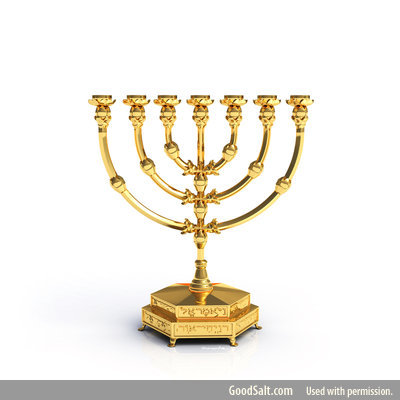 o the south we see the seven-branched menorah (or, lampstand) which was to continuously light the sanctuary. Jesus said:
o the south we see the seven-branched menorah (or, lampstand) which was to continuously light the sanctuary. Jesus said:
“I am the light of the world. He who follows Me shall not walk in darkness, but have the light of life.” (John 8:12)
It is a mistake to think of God as Yin and Yang – a union of light and darkness. John says, “God is light, and in Him is no darkness at all.” (1 John 1:5). Jesus is “the brightness of His (God’s) glory, and the express image of His person.” (Hebrews 1:3). In Jesus we see the glory (character) of God manifested in all its brightness.
“For God, who commanded the light to shine out of darkness (at creation), hath shined (His character) in our hearts (of darkness/confusion), to give the light (truth) of the knowledge of the glory (character) of God in the face of Jesus Christ.” (2 Corinthians 4:6)
This is why Paul wrote:
“But their minds were blinded (confused concerning the character of God). For until this day the same veil (of confusion) remains unlifted in the reading of the Old Testament, because the veil is taken away in Christ (He manifested God’s true character). But even to this day, when Moses (the Torah/Law, first five books of the Old Testament) is read, a veil (of confusion) lies on their heart. Nevertheless when one turns to the Lord (Jesus), the veil (confusion) is taken away. Now the Lord is the Spirit; and where the Spirit of the Lord is, there is liberty. But we all, with unveiled face, beholding as in a mirror the glory (character) of the Lord, are being transformed into the same image from glory to glory, just as by the Spirit of the Lord.” (2 Corinthians 3:14-18)
Jesus also said, “Ye (His people) are the light of the world ...” (Matthew 5:14 -16). We are to reflect the light of Jesus to draw the whole world unto Him; for when they see Him, they will see the Father working in Him. As we daily partake of God’s word (represented by the table of showbread), light (a symbol of truth) begins to illuminate us. This light from Jesus is so that we “shall not walk in darkness (confusion)” concerning God’s character. David wrote, “The entrance of thy words giveth light; it giveth understanding unto the simple.” (Psalm 119:130). And again he says, “Thy word is a lamp unto my feet, and a light unto my path.” (Psalm 119:105). In the book of Proverbs we read, “But the path of the just is as a shining light that shineth more and more unto the perfect day.” (Proverbs 4:18). As we permit Jesus to minister in us through His indwelling Spirit, we will be enlightened more and more with God’s true character, falling in love with Him as we begin to turn from our old thinking of fear and death, to a faithful love and trust which brings life.
“Inasmuch then as the children have partaken of flesh and blood, He (Jesus) Himself likewise shared in the same, that through death He might destroy him who has the power of death, that is, the devil, and release those who through fear of death were all their lifetime subject to bondage.” (Hebrews 2:14, 15)
Jesus says we are not to hide this light because people “do not light a candle, and put it under a bushel, but on a candlestick; and it giveth light unto all that are in the house. Let your light so shine before men, that they may see your good works, and glorify your Father which is in heaven.” (Matthew 5:14-16). We, as the reflected light of Jesus, are to joyfully spread that light of God’s character to all within our sphere of influence.
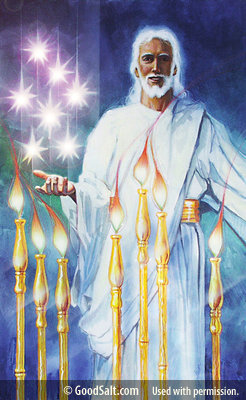
In prophetic vision, the prophet John saw Jesus standing at the Menorah wearing His priestly garment:
“And I turned to see the voice that spake with me. And being turned, I saw seven golden candlesticks; And in the midst of the seven candlesticks one like unto the Son of man, clothed with a garment down to the foot, and girt about the paps with a golden girdle. His head and His hairs were white like wool, as white as snow; and His eyes were as a flame of fire; And His feet like unto fine bronze, as if they burned in a furnace.” (Revelation 1:12, 13)
The Altar of Incense
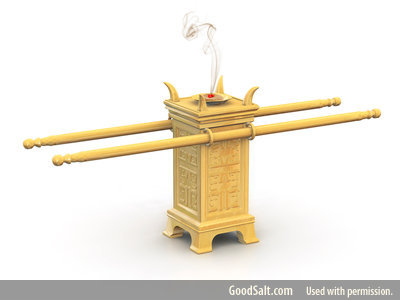 Straight ahead in the Holy Place we see the “Altar of Incense.” This altar was placed just before the veil which separated the first and second apartments of the sanctuary. The incense which was burnt on the altar would rise and float over the top of the veil into the Holy of Holies. John, while in vision, saw an angel burning incense “that he should offer it with the prayers of all the saints upon the golden altar which is before the throne. And the smoke of the incense, with the prayers of the saints, ascended before God from the angel’s hand.” (Revelation 8:3, 4). The sweet smelling aroma from the incense represents the merits of Christ (see Ephesians 5:2) thus the incense represents Jesus’ merits being mingled with our prayers of acceptance to God’s forgiveness.
Straight ahead in the Holy Place we see the “Altar of Incense.” This altar was placed just before the veil which separated the first and second apartments of the sanctuary. The incense which was burnt on the altar would rise and float over the top of the veil into the Holy of Holies. John, while in vision, saw an angel burning incense “that he should offer it with the prayers of all the saints upon the golden altar which is before the throne. And the smoke of the incense, with the prayers of the saints, ascended before God from the angel’s hand.” (Revelation 8:3, 4). The sweet smelling aroma from the incense represents the merits of Christ (see Ephesians 5:2) thus the incense represents Jesus’ merits being mingled with our prayers of acceptance to God’s forgiveness.
“Many human beings have been educated to think that prayer is offered in an effort to change God’s mind or attitude toward the sinner, informing the infinite God of something that He does not already know, or persuading Him to grant some blessing which He was previously unwilling to give ... Men have been taught to beg the Lord for mercy and forgiveness rather to claim these blessings as the promises of a merciful and pardoning Father. The Lord is approached with an attitude of uncertainty as to whether or not He would be willing to grant the heartfelt needs of the humble, repentant soul. Such is not the character of God. He is eager to bless and quick to forgive, not willing that any should perish, but desiring all to come to repentance [2 Peter 3:9]. ‘For Thou, Lord, art good, and ready to forgive; and plenteous in mercy unto all them that call upon Thee’ (Psalm 86:5).” (Ty Gibson, The Path of the Just, p. 61)
In the book of Psalms we read:
"May my prayer be set before You like incense, my uplifted hands like the evening offering." (Psalm 141:2, Berean Study Bible)
In Luke chapter 1 we see Zechariah ministering at “the alter of incense” while “the entire crowd of people was praying outside at the hour of incense” (Vss. 5-11). This "hour of incense" (prayer) was the "ninth hour" of the day (around 3pm our time) as can be seen from the book of Acts: "Now Peter and John went up together into the temple at the hour of prayer, being the ninth hour" (Acts 3:1).
The Holy of Holies
It is interesting to learn that, just as the priests of old had a two-apartment ministration in the sanctuary tent, Jesus, our High Priest, also has a two-apartment ministration inside the sanctuary which the Lord pitched and not man. Again the book of Hebrews brings this truth out. In Hebrews 9 we read:
“For there was a tabernacle made: the first, wherein was the candlestick, and the table, and the showbread; which is called the sanctuary.” (Hebrews 9:2)
Notice Paul is referring to the first apartment of the sanctuary. He speaks of the menorah (candlestick) and table of showbread which were inside the first apartment. Then he begins to describe the second apartment by saying:
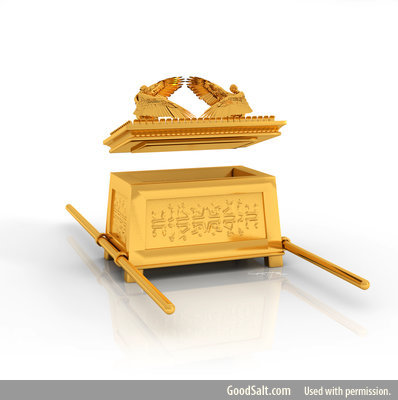 “And after the second veil, the tabernacle which is called the Holiest of all; which had the golden censer, and the ark of the covenant ... wherein was ... the tables of the covenant.” (Hebrews 9:3, 4)
“And after the second veil, the tabernacle which is called the Holiest of all; which had the golden censer, and the ark of the covenant ... wherein was ... the tables of the covenant.” (Hebrews 9:3, 4)
Please note: the “golden censer” mentioned here is not the altar of incense, but is a censer in which the high priest put some of the coals from the altar and carried into the second apartment to perform a special ministry during the Day of Atonement inside the Holy of Holies.
So, whenever the author speaks of the “first tabernacle” we know he’s referring to “the Holy Place” or, first apartment of the sanctuary. When he mentions the “second tabernacle” we know he’s referring to the “Holy of Holies” or, second apartment. Notice in verse 5 that the author (when describing more about the second apartment) says, “of which we cannot now speak particularly (or ‘in detail’).” So, at this time in the Paul’s life he could not speak of the second apartment’s meaning in detail. Why is this?
“Now when these things were thus ordained, the priests went always into the first tabernacle (Holy Place), accomplishing the service of God. But into the second (Holy of Holies) went the high priest alone once every year ... The Holy Spirit this signifying, that the way into (or ‘purpose of’- compare Matthew 21:32) the holiest of all was not yet made manifest, while as the first tabernacle (Holy Place) was yet standing (or ‘still functioning’): which was a figure (symbol) of the time then present (or ‘for the present time’), in which were offered both gifts and sacrifices, that could not make him that did the service perfect, as pertaining to the conscience. Which stood only in meats and drinks, and divers washings, and carnal ordinances, imposed on them until the time of reformation (or ‘cleansing’).” (Hebrews 9:6-10)
Paul could not go into detail concerning the meaning of the heavenly second apartment ministry because the heavenly first apartment ministry was in full function in his day. Only when the first apartment ministry reached its end could the full meaning of the second apartment ministry be understood (or, revealed). The Amplified Version of the Bible states Hebrews 9:9 like this:
“Seeing that that first [outer portion of the] tabernacle was a parable - a visible symbol or type or picture of the present age. In it gifts and sacrifices are offered, and yet are incapable of perfecting the conscience or of cleansing and renewing the inner man of the worshipper.” (Keep in mind that all brackets in this quote are directly taken from the actual Amplified Bible)
Therefore, we can now conclude that, just as the priests would carry the slain lamb’s blood into the first apartment of the earthly sanctuary, Jesus (our High Priest) entered the first apartment of the heavenly sanctuary after He was slain upon the cross. Paul said that the ministry inside the first apartment of the heavenly sanctuary was “functioning” or, going on in “the present age” or, during his life time. He says that that first apartment ministry is “incapable of perfecting the conscience or of cleansing and renewing the INNER MAN of the worshipper.” The perfecting or cleansing of the “inner man” is not part of the ministry inside the “outer portion” of the tabernacle (the Holy Place).
We have seen in our previous study that, in Leviticus 16, the second apartment (or, ‘inner portion’) ministry of the earthly sanctuary does indeed involve a cleansing work. This cleansing took place on Yom Kippur (Day of Atonement) when all the blood that had accumulated in the sanctuary was cleansed (see, verses 19 and 30). Paul also speaks of this cleansing ministry in Hebrews chapter 9 by stating the heavenly Holy of Holies needs cleansing as did the earthly:
“It was therefore necessary that the patterns of the things in the heavens (the earthly sanctuary) should be purified (cleansed) with these (blood of animals), but the heavenly things themselves (the heavenly sanctuary) with better sacrifices than these (meaning the heavenly sanctuary is to be cleansed with better sacrifices – Christ).” (Hebrews 9:23)
So, we can see that the heavenly sanctuary does need cleansing, but it will not be with the blood of animals because “it is not possible that the blood of bulls and of goats should take away sins” (Hebrews 10:4). It will be cleansed by Jesus’ blood! God told Moses, “For the life of the flesh is in the blood: and I have given it to you upon the altar to make an atonement for your souls: for it is the blood (life) that maketh an atonement for the soul.” (Leviticus 17:11). Only the pure life of Jesus can purify (cleanse) the sinner!
“For if, when we were enemies, we were reconciled to God by the death of His Son, much more, being reconciled, we shall be saved by His life.” (Romans 5:10)
As said before, during the earthly ministry of the sanctuary, the blood which had built up on the altar as well as in the Holy Place was not cleansed until Yom Kippur when the high priest, and only the high priest, would go into the Holy of Holies and cleanse the sanctuary (Leviticus 16). The blood being applied to the pieces of furniture throughout the sanctuary represents a record of sin and our crucifying the life of Christ afresh:
“The sin of Judah is written with a pen of iron, and with the point of a diamond: it is graven upon the table of their heart, and upon the horns of your altars.” (Jeremiah 17:1)
These records are what Daniel saw when he wrote:
I beheld till the thrones were cast down, and the Ancient of days (God, the Father) did sit, whose garment was white as snow, and the hair of His head like the pure wool: His throne was like the fiery flame, and His wheels as burning fire. A fiery stream issued and came forth from before Him: thousand thousands ministered unto Him, and ten thousand times ten thousand stood before Him: the judgment was set, and the books were opened. I beheld then because of the voice of the great words which the horn spake: I beheld even till the beast was slain, and his body destroyed, and given to the burning flame. As concerning the rest of the beasts, they had their dominion taken away: yet their lives were prolonged for a season and time. I saw in the night visions, and, behold, one like the Son of man (Jesus) came with the clouds of heaven, and came to the Ancient of days, and they brought Him near before Him.” (Daniel 7:9-13)
We saw in our previous study that the cleansing of the sanctuary on Yom Kippur, when the high priest ministered at the Ark of the Covenant, was considered a time of judgment. This is exactly what John saw in heaven:
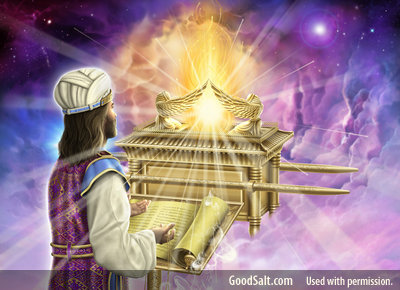 “And the seventh angel sounded; and there were great voices in heaven, saying, The kingdoms of this world are become the kingdoms of our Lord, and of his Christ; and He shall reign for ever and ever. And the four and twenty elders, which sat before God on their seats, fell upon their faces, and worshipped God, Saying, We give thee thanks, O Lord God Almighty, which art, and wast, and art to come; because Thou hast taken to thee thy great power, and hast reigned. And the nations were angry, and thy wrath is come, and the time of the dead, that they should be judged … And the temple of God was opened in heaven, and there was seen in His temple the Ark of His Covenant: and there were lightnings, and voices, and thunderings, and an earthquake, and great hail.” (Revelation 11:15-18, 19)
“And the seventh angel sounded; and there were great voices in heaven, saying, The kingdoms of this world are become the kingdoms of our Lord, and of his Christ; and He shall reign for ever and ever. And the four and twenty elders, which sat before God on their seats, fell upon their faces, and worshipped God, Saying, We give thee thanks, O Lord God Almighty, which art, and wast, and art to come; because Thou hast taken to thee thy great power, and hast reigned. And the nations were angry, and thy wrath is come, and the time of the dead, that they should be judged … And the temple of God was opened in heaven, and there was seen in His temple the Ark of His Covenant: and there were lightnings, and voices, and thunderings, and an earthquake, and great hail.” (Revelation 11:15-18, 19)
Daniel says he saw “thrones were cast down.” In the New King James Version it says it a little better: “I watched till thrones were put in place, and the Ancient of Days was seated.” Here we see that God, the Father has moved from sitting on the throne in the Holy Place to sitting upon a throne in the Holy of Holies. Soon after this, Jesus follows Him and the clouds of heaven (a symbol representing angels, cf. Psalm 68:17, 104:3) bring Him near before His Father.
It is of no coincidence that, after John sees into the heavenly Holy of Holies in Revelation 11, he writes this in Revelation 14:
“And I saw another angel fly in the midst of heaven, having the everlasting gospel to preach unto them that dwell on the earth, and to every nation, and kindred, and tongue, and people, Saying with a loud voice, Fear God, and give glory to Him; for the hour of His judgment is come: and worship Him that made heaven, and earth, and the sea, and the fountains of waters.” (Revelation 14:6, 7)
This judgment message is all about giving glory to God by vindicating His name (character). Jesus will raise up a people “having His Father's name (character) written in their foreheads (reasoning/thinking).” (Verse 1). God will correct our thinking concerning His character if we let Him. As a result of this correct thinking, John hears a second angel saying “Babylon is fallen, is fallen, that great city, because she made all nations drink of the wine of the wrath of her fornication.” (Verse 8). As a result of our corrected thinking, Babylon, a word that means confusion, will fall away from our thoughts and actions.
Daniel says that “judgment was GIVEN to the saints of the Most High.” (Daniel 7:22). The word “given” here is to be understood as “imparted.” By the Father’s indwelling Spirit He will cleanse us from every lying argument and every preconceived idea that the father of lies has instilled deep into our hearts and minds (2 Corinthians 10:3-5). Our Father faithfully invites us to investigate Him as an open book (Psalm 34:8), as He longs to purge every abomination that has desolated our soul temple through “the Daily” corruption of pagan theology (see, our study on The Little Horn, Part One). God desires to impart (give) us righteous judgment/discernment so that we will stop misjudging and condemning Him. We will all make a decision. The heart of the judgment is not God's decision about us, but our decision about Him – for it is the hour of HIS judgment:
“ … yea, let God be true, but every man a liar; as it is written, That Thou (God) mightest be justified in Thy sayings, and mightest overcome when Thou (God) art judged.” (Romans 3:4)
The record books that are opened are not for condemnation nor punishment as we usually think. John writes that “God is love” (1 John 4:8), and Paul says that love “keeps no record of wrongs” (1 Corinthians 13:5). Jesus told us, “For the Father judgeth no man, but hath committed all judgment unto the Son.” (John 5:22). Learning that the Father does not judge is mind-blowing to our faulty thinking. What’s even more striking is Jesus’ words saying, “Ye judge after the flesh; I judge no man.” (John 8:15). So, neither the Father nor the Son judge any man. Take note that the word “judge” can also mean “condemn.” God nor His Son ever condemn any man. Their judgment (decision) is always healing and restorative, never condemning and destructive.
These record books used during the time of judgment serve as spiritual health records, much like you have from your doctor. The judgment is not about punishment, but for a proper diagnosis of our sin problem. If you were to go see a doctor and they diagnosed you with cancer, your doctor would not start handing out punishments. He/she would start a treatment of healing.
What would you think of this doctor if they looked at your health record, and seeing you have been diagnosed with cancer, they proceed to simply rip out all the bad pages from your record and replace them with clean white pages and then pronounce you are cured because your record has been cleansed? Or better yet, what if the doctor said, “Here’s what we are going to do. I have a son who is perfectly healthy. I will replace your record with his and this will clean your record.” Would you trust that doctor? I certainly hope not. Simply replacing pages of records will not heal and restore you. Then why is it that we hear this sort of teaching concerning salvation in the churches today? It is because of our faulty view of God’s Law:
“Under imposed law models, there is nothing inherently wrong with breaking the law. Going 50-mph in a 45-mph zone doesn’t naturally result in any injury or harm to the violator of the law. The violator must be caught by the authorities, have their deeds recorded, their case presented before a judge, and then receive an arbitrarily determined penalty inflicted as punishment. This is human law, not Creator law. This is the way of sinful beings, not a sinless God. This idea of law is the basis of penal substitution theology. It is founded on a lie about God’s law and presents a view of God’s government that is functionally no different than sinful human governments. In the penal view, God becomes the source of inflicted pain, suffering, and death. It is taught, in the penal view, that God’s use of power to torture and kill is ‘justice,’ because sin must be punished. Such bad theology is the fruit of accepting Satan’s lie about God’s law and that God, in order to be just, must punish sin. In this view, rather than God working to heal and save the spiritually terminal, God becomes the one from whom we need to be protected, resulting in theologies that have, as their function, the sole purpose of hiding and protecting us from God, rather than heal us to be fit to live in His presence. Consider the many ideas taught in Christianity that have, as their function, the purpose of hiding us from God. Why? Because people wrongly believe that if God saw their sin and their sinfulness, that He would be required to lash out with wrath and anger to inflict pain and suffering to punish them for their sin. This is exactly what Satan wants people to think, because this idea keeps people hiding themselves from God. But David of old prayed, ‘search me and see the wicked way in me’. He didn’t want to hide his sinfulness from God, because he knew God wouldn’t punish him, but was the only One who could heal him, so he prayed, ‘create in me a clean heart and renew a right spirit within me.’ God’s end-time people are to present a message to the world that calls them back to worship the Designer, and to worship ‘him who made the heavens, earth, sea and foundations of water.’ (Rev. 14:7). This is a call to reject the dictator-views of God and embrace the Creator, Designer, and Builder of reality! This means we must reject imposed law and all the false penal legal theology upon which it is founded.” (Dr. Timothy Jennings, Penal Substitution versus Design Law—What’s the Difference?)
The truth is, when the veil of confusion is removed, we only see a loving God “investigating” us, as open books before Him, searching for, and diagnosing ("judging"), our cancerous sin problem. The “books” in heaven are the record of our lives and that which is engraved upon our hearts. In return, our lives are recorded in our Father’s heart, just as any loving parent carries sacred memories of their children do. This was displayed for us in the “breastplate of judgment” that the high priest would wear: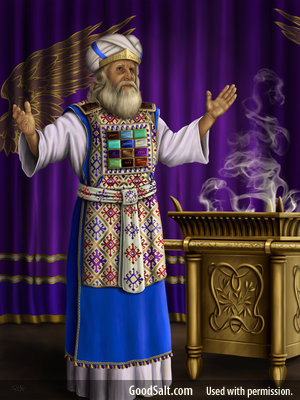
“Whenever he enters the sanctuary, Aaron is to carry the names of Israel’s sons over his heart on the breastplate of judgment, as a continual reminder before the LORD.” (Exodus 28:29)
Jesus, our High Priest does the same. It is therefore true that God has a perfect record of our lives, but it is not recorded for the purposes that we think in terms of surveillance, judgment and punishment. It is recorded because when someone loves another person, they are constantly watching over them and caring for them and thinking of them.
“Are not five sparrows sold for two copper coins? And not one of them is forgotten before God. But the very hairs of your head are all numbered. Do not fear therefore; you are of more value than many sparrows.” (Luke 12:6, 7)
“Many, O LORD my God, are Your wonderful works which You have done; and Your thoughts toward us cannot be recounted to You in order; if I would declare and speak of them, they are more than can be numbered.” (Psalm 40:5)
God wants to replace the sin which has been engraved upon our hearts with His Law of righteousness (see again, Hebrews 8:10); for God’s Law is a transcript of His own character: “Hearken unto Me, ye that know righteousness, the people in whose heart is My Law …” (Isaiah 51:7).
Knowing our sinful condition, He delicately seeks to cleanse our record books of sin. How does He do this? It is not by Jesus manipulating (changing) the record books as some might teach, or hiding us behind Himself in order to protect us from an angry Father as traditional Christianity may teach. No. But rather by our Father injecting (uniting) us with His life (Spirit) through Jesus (our only Remedy) so that our sins go into “remission.” As a result, our “old man” (nature) dies, thus bringing healing, until WE are “conformed (changed) to the image of His Son” (Romans 8:29) and have a clean bill (record) of health—no more sinning.
This record of our sins will not be cleansed until Jesus begins His ministry inside the second apartment of the heavenly sanctuary; for it is at that time when mankind will truly begin to understand God’s true character and His Law. This is why the Law was placed inside the Ark of the Covenant, under the Mercy Seat. The results will be a cleansing from the very practice of sinning; “for sin is the transgression of the Law” (1 John 3:4).
Even though an atonement, forgiveness and cleansing of the “outer man” were revealed at the altar of burnt offerings and the laver, a special Day of Atonement (or, cleansing) was still performed at the end of the year. Therefore, although there was an atonement and forgiveness revealed at the cross (Romans 5:10, 11), there will still be a special heavenly Day of Atonement (a heavenly Yom Kippur) near the close of earth’s history when God will perform a special (or, final) atonement to cleanse the “inner man” of the believer! The atonement made at the altar of burnt offerings (representing the cross) satisfied man's view of the atonement, while the atonement made in the Holy of Holies will satisfy God's view of the atonement when man is cleansed from his false views of God's character.
“God does not need to be reconciled to man, for, like the mother’s love, His love ever follows us, even when we are in the downward way, seeking to bring us back to Him. But man needs to be reconciled to God. In some way there must be an atonement made. Not that God’s wrath must be satisfied, so that He will look with favor upon offending man, but that God’s love must be so manifest, in spite of the existence of suffering and sin, that men will turn their hearts toward Him, as the flower toward the sun. … The word ‘atonement’ means at-one-ment. Sin had brought misery, and misery had brought a misunderstanding of God’s character. Thus men had come to hate God instead of loving Him; and hating Him, the one Father, men also hated man, their brother. Thus, instead of the one family and the one Father, men were separated from God and from each other,
and held apart by hatred and selfishness. There must be an atonement. An atonement can be made only by God so revealing his love, in spite of sin and sorrow, that men's hearts will be touched to tenderness; and they, being delivered from Satan's delusions, may see how fully and terribly they have misunderstood the divine One, and so have done despite to the Spirit of his grace. Thus they may be led, as returning brethren, to come back to the Father's house in blissful unity. The atonement is not to appease God’s wrath, so that man dare come to him, but it is to reveal His love, so that they will come to Him. It was not Christ reconciling God unto the world, but God in Christ reconciling the world unto himself. It is nowhere said that God needed to be reconciled unto us; he says, 'I have not forsaken you, but you have forsaken me.'" (George Fifield, God Is Love, pp. 46, 48)
And once this atonement is made and we are fully reconciled to God, paganism and it's appeasement theology, incoporated into Christianity by the little horn (the papacy) will be cleansed from our thinking.
"'But,' someone will say, 'You have made the reconciliation all on the part of men; I have always been taught that the death of Christ reconciled God to man; that Christ died to satisfy God’s justice, and to appease Him.' Well, we have left the matter of reconciliation just where the Scriptures have put it; and while they have much to say about the necessity for man to be reconciled to God, they never once hint of such a thing as the necessity for God to be reconciled to man. To intimate the necessity for such a thing is to bring a grave charge against the character of God. The idea has come into the Christian Church from the Papacy, which in turn brought it from Paganism, in which the only idea of God was of a being whose wrath must be appeased by a sacrifice. Stop a moment, and think what reconciliation means. The existence of enmity is the only necessity for reconciliation. Where there is no enmity, there is no necessity for reconciliation. Man is by nature alienated from God; he is a rebel, full of enmity. Therefore man needs to be reconciled-to have his enmity taken away. But God has no enmity in His being. 'God is love.' Consequently there is no necessity for Him to be reconciled; there is no possibility of such a thing, for there can be no reconciliation where there has been no enmity." (E.J. Waggoner, Present Truth UK, September 21, 1893)
Did Daniel Understand These Concepts?
The question now is, did Daniel understand what he was seeing up to this point? Although Daniel knew the different functions of the sanctuary service, it is doubtful he understood the full meanings as we have been sharing. We learned in a previous study that at the end of chapter 8, Daniel says, “And I Daniel fainted, and was sick certain days; afterward I rose up, and did the king's business; and I was astonished at the vision, but none understood it.” (Daniel 8:27).
There is, however, a clue that God may have been trying to share with Daniel (and with us). That clue is found in the two different languages Daniel was inspired to use when writings his book. Chapters 2-7 are written mostly in Aramaic, while chapters 8-12 are written mostly in Hebrew. Could there be a prophetic reason for this?
“To the Jewish people, it was Hebrew that was ‘the Holy Tongue’, whereas Aramaic was seen as ‘the language of the Evil Force’ [From Zohar]. Not that the latter was rejected altogether, but that it was regarded as a second fiddle language to Hebrew—the real ‘tongue of the fathers’ and medium of ordinary speech. Thus the Jerusalem Talmud declares that: ‘Four languages are of value: Greek for song, Latin for war, Aramaic for dirges, and Hebrew for speaking’. That was the place for Aramaic—in ‘dirges’. But to Hebrew belonged the high ground of daily speech (‘for speaking’) and worship. Thus for a Jewish father not to speak to his son ‘in Hebrew’, from the time he was a toddler, and teach him the law, was ‘as if he had buried him’. Concerning Aramaic, by contrast, the rabbis warned: ‘Whoever makes personal requests [in prayer] in Aramaic, the ministering angels pay no attention, since angels do not understand Aramaic’. This, of course, is not a canonical [biblical] position, but merely reflects the depth of feeling against Aramaic among the Jewish scholars.” (danielbenyaacovysrael.blogspot.com, June 2013)
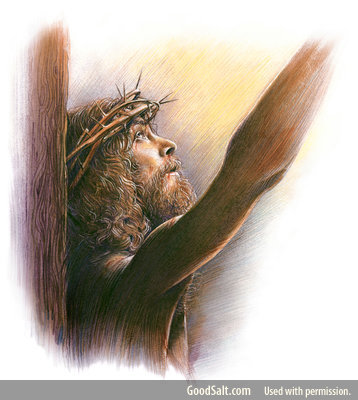 Many believe that Jesus spoke Aramaic, but there is ample proof to suggest otherwise, and that His native language was Hebrew. Yet upon the cross Jesus utters a phrase using the Aramaic language:
Many believe that Jesus spoke Aramaic, but there is ample proof to suggest otherwise, and that His native language was Hebrew. Yet upon the cross Jesus utters a phrase using the Aramaic language:
“And about the ninth hour Jesus cried out with a loud voice, saying, Eli, Eli, lama sabachthani? that is, My God, My God, why have You forsaken Me?” (Matthew 27:46)
Why do you suppose Jesus was speaking “the language of the Evil Force”? Paul says that God allowed His Son “who knew no sin to be sin for us” (2 Corinthians 5:21), and that “by the grace of God [He/Christ] should taste death for every man.” (Hebrews 2:9). In crying out a phrase that suggest God has forsaken Him (in Aramaic), Christ was crying out what every unbelieving sinner cries out because of their faulty belief concerning God’s forgiveness. Christ dying on the cross was a revelation of what the unbelieving sinner will go through in the end – utter mental anguish of guilt and shame because they refuse to accept that God freely forgives. (Please see the book The Lake of Fire and the Second Death for a deeper look at this). Jesus took on this faulty mindset because He had to die the way a sinner will die. He had to reveal the deadly force of sin as it crushed His soul and blinded Him to the Father’s merciful face. When Jesus uttered these words, He was quoting from Psalm 22:
“My God, my God, why hast thou forsaken me? why art Thou so far from helping me, and from the words of my roaring? O my God, I cry in the daytime, but Thou hearest not …” (Psalm 22:1, 2)
This is the anguish an unbelieving sinner cries out, not believing that God is right there with His hand reached out to save them. Notice verse 24:
“For He hath not despised nor abhorred the affliction of the afflicted; neither hath He hid His face from him; but when he cried unto Him, He heard.” (Psalm 22:24)
Jesus could not reach out and grasp His Father’s hand because an unbelieving sinner, who doubts God’s forgiveness, would not do this. After Cain killed his brother Abel and was facing the natural consequences of such an act, most Bibles quote him as complaining to God saying, “My punishment is greater than I can bear.” (Genesis 4:13). However, the literal Hebrew says things a little different: “My iniquity is greater than that it may be forgiven.” Sin had caused Cain to doubt God’s forgiveness – a belief we all have inherited from our father Adam. It is interesting that this is brought out in the Aramaic Bible in Plain English:
“And Qayn (Cain) said to LORD JEHOVAH, ‘My crime is greater than what may be forgiven.’”
Here it is in a couple other versions:
“And Cain said to the Lord God, My crime is too great for me to be forgiven.” (Brenton Septuagint Translation)
“And Cain said to the Lord: My iniquity is greater than that I may deserve pardon.” (Douay-Rhimes Bible)
The Bible says, “Grieve not the holy Spirit of God, whereby ye are sealed unto the day of redemption.” (Ephesians 4:30). God’s Spirit is what seals us, or prepares us for the day when Christ will come to redeem His people. If we continually reject the only avenue by which God can work in our lives, then there is nothing more that God can do for us. That is why there is no forgiveness for the blasphemy of the Holy Spirit. Not that God is ever unwilling to forgive, but that the person who does this is unwilling to repent and be forgiven. He chooses not to believe, thus they become like those who “judge themselves unworthy of everlasting life” (Acts 13:46). It all depends on how YOU react and judge His words of promise:
“And if any man hear My (Jesus’) words, and believe not, I judge him not: for I came not to judge the world, but to save the world. He that rejecteth Me, and receiveth not My words, hath one that judgeth him: the word that I have spoken, the same shall judge him in the last day.” (John 12:47, 48)
Right after Jesus says, “I judge no man” in John 8:15, He adds, “And yet if I judge, My judgment is true: for I am not alone, but I and the Father that sent Me.” (Verse 16). The book of Psalms teaches us how God executes judgment:
“The LORD is known by the judgment He executes; the wicked is snared in the work of his own hands.” (Psalm 9:16)
The very decisions that individuals, churches, and nations take are allowed to come back upon the very ones who make these decisions for good or for evil. God does not intervene to apply force, but rather He allows events to follow their natural course until that which a person sows, is reaped in their own harvest.
“Do not be deceived, God is not mocked; for whatever a man sows, that he will also reap. For he who sows to his flesh will of the flesh reap corruption, but he who sows to the Spirit will of the Spirit reap everlasting life.” (Galatians 6:7, 8)
John wrote, “My little children, these things write I unto you, that ye sin not. And if any man sin, we have an advocate with the Father, Jesus Christ the righteous.” (1 John 2:1). Jesus as our Advocate does not mean that He and us are trying to get God to reconcile with us, but that He and the Father are working together to reconcile us to Them. The meaning in the Greek is that Jesus is our “Advocate along-with the Father.”
“What then shall we say about these things? If God is for us, who can be against us?” (Romans 8:31)
“When Jesus was dying upon the Cross, He carried the weight of the sins of the world. He was surrounded by evil men taunting Him and all the while Satan is pressing upon Him the thought that His Father has forsaken Him. The very words of Jesus in Aramaic convey that in the darkness He is oppressed by a foreign influence that is the language of lament and death. In this context the writing of Daniel 7 in Aramaic in contrast to the Hebrew of Daniel 8 is highly significant. In Daniel 7, God is perceived through the lens of a foreign influence. The language of condemnation and death is used as the lens in which to view the work of God in judgment. When the judgment is described in Daniel 8 there is no courtroom scene. It simply says: ‘And he said to me, For two thousand three hundred days; then the sanctuary shall be cleansed.’ (Daniel 8:14) … Within the Most Holy Place of the Sanctuary system there are no books of record outside of the 10 Commandments and the book of the law. There are no symbols of a courtroom in this space. Daniel 2–7 is given in Aramaic because these chapters consist of prophecies mainly dealing with political matters and thus are considered to be of interest to Gentiles (Aramaic was the lingua franca of the time). In Daniel 7 this view of God as a courtroom Judge according to man’s view of Him is given in Aramaic to underscore the point that this is a perspective foreign to heaven, given for those who have a vail upon their heart (2 Corinthians 3:15), for the Father does not judge and condemn any person. Aramaic is a combination of Chaldee and Hebrew. It combines the language of Jerusalem with the language of Babylon and this is highly significant. The judgment scene of Daniel 7 mixes the judgment process of God with the judgment process of Babylon. In the Hebrew language of Daniel 8, what is described is simply a restoration of things that were out of order. When Adam judged and condemned God in thinking that God wanted to kill his wife [Eve], he placed the temple of his mind out of order. It was not in the correct state.” (Adrian Ebens, As You Judge, pp. 109, 110)
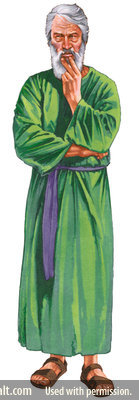 This is why the sanctuary (the temple of our mind) needs to be cleansed during “the time of the end” before Jesus returns. God desires to cleanse our faulty thinking concerning His character and His Law, so we do not judge ourselves unto condemnation.
This is why the sanctuary (the temple of our mind) needs to be cleansed during “the time of the end” before Jesus returns. God desires to cleanse our faulty thinking concerning His character and His Law, so we do not judge ourselves unto condemnation.
Daniel said he did not understand the timing of the 2,300 days and when this cleansing process would begin. Daniel chapter 8 closes with him saying, “I was astonished at the vision, but none understood it” (Verse 27) because the angel Gabriel had not revealed the portion of the vision concerning the 2,300 days. In order for us to understand this portion of the vision, is it not logical to turn to the next chapter – Daniel 9?
In Daniel chapter 9 Daniel is given a 70-week prophecy (verse 24) to consider. At first glance this seems unrelated to what we have been studying from Daniel 2, 7 and 8 but when we take a closer look, we see that it is the next piece of the puzzle.
So let’s turn to Daniel 9 and answer the question, When Was the Sanctuary cleansed?

